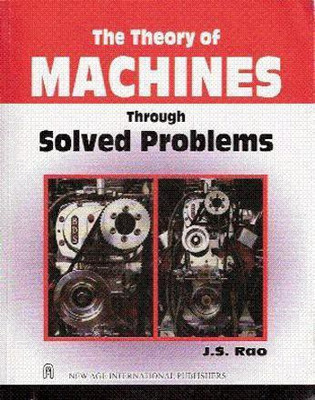Theory of Machines Through Solved Problems,the(English, Paperback, Rao J. S.)
Quick Overview
Product Price Comparison
The Theory of Machines or Mechanism and Machine Theory is a basic subject taught in engineering schools to Mechanical Engineering students. This subject lays the foundation on which mechanical engineering design and practice rests with. It is also a subject taught when the students have just entered engineering discipline and are yet to formulate basics of mechanical engineering. This subject needs a lot of practice in solving engineering problems and there is currently no good book explaining the subject through solved problems. This book is written to fill such a void and help the students preparing for examinations. It contains in all 336 solved problems, several illustrations and 138 additional problems for practice. Basic theory and background is presented, though it is not like a full-fledged text book in that sense. This book contains 20 chapters, the first one giving a historical background on the subject. The second chapter deals with planar mechanisms explaining basic concepts of machines. Kinematic analysis is given in Chapter 3 with graphical as well as analytical tools. The synthesis of mechanisms is given in Chapter 4. Additional mechanisms and coupler curve theory is presented in Chapter 5. Chapter 6 discusses various kinds of Cams, their analysis and design. Spur gears, helical gears, worm gears and bevel gears and gear trains are extensively dealt with in Chapters 7 to 9. Hydrodynamic thrust and journal bearings (long and short bearings) are considered in Chapter 10. Static forces, inertia forces and a combined force analysis of machines is considered in Chapters 11 to 13. The turning moment and flywheel design is given in Chapter 14. Chapters 15 and 16 deal with balancing of rotating parts, reciprocating parts and four bar linkages. Force analysis of gears and cams is dealt with in Chapter 17. Chapter 18 is concerned with mechanisms used in control, viz., governors and gyroscopes. Chapters 19 and 20 introduce basic concepts of machine vibrations and critical speeds of machinery. A special feature of this book is the availability of three computers aided learning packages for planar mechanisms, their analysis and animation, for analysis of cams with different followers and dynamics of reciprocating machines, balancing and flywheel analysis. About The Author Prof. J.S. Rao (Hons.), M. Tech, Ph.D., D.Sc, taught at the Indian Institute of Technology, Kharagpur and Delhi for over 30 years. He has also taught at the University of Surrey, as a Commonwealth Fellow; at National Institute of Applied Sciences, Lyon; Concordia University, Montreal; Rochester Institute of Technology and Gesamthoch schule in Kassel as Visiting Professor. Prof. Rao started a new Centre on Industrial Tribology, Machine Dynamics and Maintenance Engineering at IIT, Delhi in 1977. He also served as Science Counselor at the Indian Embassy in Washington during 1984-88. Prof, Rao has been the Chairman of IFToMM Rotor Dynamics Committee from 1983-90 and is a member of IFToMM Executive Council and Chairman of IFToMM Commission on Conferences. Prof. Rao has been the Founder President of Association of Machines and Mechanisms in India and is the President of Indian Society of Theoretical and Applied Mechanics. He is a member of Indian National Academy of Engineering and American Society of Mechanical Engineers. He is also Chairman of Vibration and Rotor Dynamics Group of the Aeronautical Research and Development Board Propulsion Panel, and member of ASME IGT Structures and Dynamics Committee. Prof. Rao produced 26 Ph.Ds and published 5 text books and over 200 papers. He has been a consultant to various organizations in India such as BHEL, GTRE and abroad such as Washington Metro Authority, Stress Technology Inc. etc. His biographical sketch is reviewed by Marquis WhoŌĆÖs who, Men of Achievement, WhoŌĆÖs who in Common wealth, Leaders in Education & Educationists WhoŌĆÖs who International, and Reference Asia. Table Of Contents Introduction Planar Mechanisms Kinematic Analysis of Mechanisms Kinematic Synthesis of Mechanisms Simple Mechanisms and Coupler Curves Cams Spur Gears Helical, Spiral, Worm and Bevel Gears Gear Trains Hydrodynamic Lubrication Static Force Analysis Intertia Force Analysis Combined Static and Inertia Force Analysis Turning Moment Diagram and Flywheel Balancing of Rotating Components Balancing of Linkages Gear and Cam Forces Mechanisms for Control: Governors and Gyroscopes Vibration Characteristics of Simple Systems: Critical Speeds


